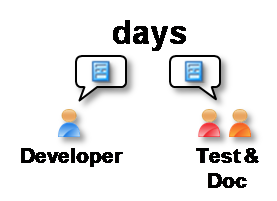
I tried to look like I was still mulling over the question when Mr. J continued his interrogation, "The description of this feature is incomplete. What should happen when the -t option is combined with -V and there are no other options given?" I was sweating and nervous, my chest felt tight and I knew I was right on the edge of panic.
I couldn't remember the answer to Mr J's question. I'm not sure I ever knew it and the customer that had asked for this new feature had gone out of business 2 months after we implemented it, which was 3 months ago. I was helpless and trapped. The harsh light and the look in his eyes wasn't helping. He knew that I didn't know. I wouldn't be able to hold out for much longer, it felt like the room was starting to spin.
Finally I couldn't take it any more. I cracked under the strain and confessed what he already suspected. "I don't know. I wrote that code so long ago, I just can't remember. I'm sorry." Mr. J shook his head and walked out of my office saying, "I'll figure it out."
Ok, so this is a bit of a dramatization loosely based on a real event, but being in the situation where you are asking about or needing information about something that happened months ago in the development process is fairly typical in a traditional development project.
Perhaps you are the developer in this situation or the person trying to write the tests for the functionality. Or perhaps you were trying to write the documentation, do the demo for the user, market it, sell it, or... use it? As an industry, we've become numb to this problem. Sure, we blame specific situations or individuals and we often try to take corrective action... but it seems to keep happening again and again.
As an industry, we try to write better requirements, but it doesn't seem to help. The tough questions keep coming. We try to take a bit more time on the design, but things just get worse. The questions get more complicated. We try to do more testing and hire "better" people, but we keep running into situations where we just don't have the answer, there's no supporting documentation, and we promise we'll try harder next time.
Why does this keep happening? What can be done to prevent it? It turns out that there is a simple explanation as well as a practical solution.



